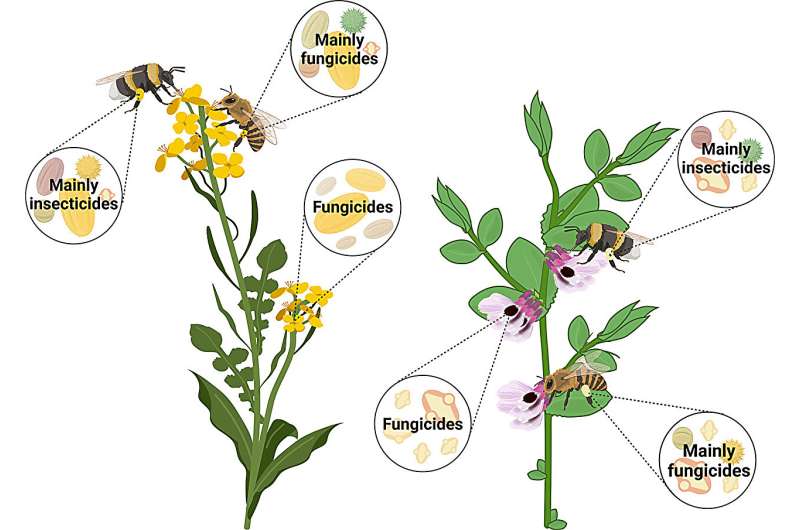This article has been reviewed according to Science X's editorial process and policies. Editors have highlighted the following attributes while ensuring the content's credibility:
fact-checked
peer-reviewed publication
trusted source
proofread
Range of pesticides, including neonicotinoids, found in pollen of different bee species

New research paints a worrying picture for the different species of bees that provide multi-million-euro pollination services in Ireland each year.
The work raises concerns about the potential wide-spread exposure to multiple chemicals from two pesticide categories (fungicides and neonicotinoid insecticides) and indicates that different bee species may be exposed differently to pesticides—meaning that assessments of pesticide risk to honey bees may not be easily extrapolated to other bees.
The scientists behind the study, from Trinity College Dublin and Dublin City University, evaluated pesticide residues in crop pollen at 12 sites in Ireland, and in pollen collected from honey bees and bumble bees from the same sites. They have just published their findings in the journal Science of the Total Environment.
Key results:
- Most pesticides detected had not been applied recently to the sampled fields—suggesting that some chemicals may persist for a long time (in the soil, which can subsequently end up in crop pollen) and/or residues may have come from plants exposed to pesticides in other places but within the foraging range of bees (in the case of bee-collected pollen)
- Crop pollen was only contaminated with fungicides; honey bee pollen was mostly contaminated with fungicides; bumble bee pollen mostly by neonicotinoid insecticides
- The highest number of compounds and most pesticide detections were in bumble bee pollen
- All five neonicotinoid insecticides assessed were found in bumble bee pollen—even though these had not been applied recently to the sampled fields
Taken in combination, these results raise significant concerns about the potential wide-spread exposure to multiple pesticides. Additionally, some previous studies have shown that when insecticides and fungicides are combined, the results may be more toxic than for each category alone.
Elena Zioga, Ph.D. Candidate in Trinity's School of Natural Sciences, is the first author of the just-published journal article. She said, "The results of this study are concerning on several levels. Of particularly great significance is the indication that different species seem to be exposed to pesticides differently based on the variation in the types and number of different pesticides found in pollen of honey and bumble bees respectively.
"Essentially, this means that using honey bees as a reference for understanding the exposure to different pesticides cannot give a complete picture. What's true for honey bees doesn't seem to be true for bumble bees, and we know that both are important for the overall pollination service and for supporting healthy ecosystems.
"It is also very worrying that the five neonicotinoids we looked for appeared in bumble bee pollen and not in crop pollen. Some of these pesticides, known to be particularly toxic, had not been applied in the fields we sampled for at least three years. This shows either that they persist for a long time in the field edges, where wildflowers grow, or that bees collected neonicotinoid-contaminated pollen from beyond the sampled fields.
"Our work also showed that neonicotinoid detection increased when the presence of wild plants in bumble bee pollen increased, and that is one of many things that require further investigation."
More information: Elena Zioga et al, Honey bees and bumble bees may be exposed to pesticides differently when foraging on agricultural areas, Science of The Total Environment (2023). DOI: 10.1016/j.scitotenv.2023.166214
Journal information: Science of the Total Environment
Provided by Trinity College Dublin




















